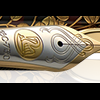Search the Community
Showing results for tags 'syringe'.
-
Hey guys, not sure if best in this forum or maybe maintenance/repair... but if it needs moved I'm sure it'll be moved. I'm sure many people probably have done this but, earlier this year I started getting into fountain pens beyond that of my Pilot V-Pen disposable. I like to keep my stuff clean s...
-
Hi folks, Here's a method to fit a syringe needle over a piston converter to suck the very last drop of ink from an ink bottle. rgds kenneth PS: Forgot to add, this method doesn't require a syringe that would take up extra space in your pen case. It's also one less item to clean. In any ca...
- 18 replies
-
- ink bottle
- snorkle
-
(and 5 more)
Tagged with:
-
I've seen them at 1" and 4", with plastic needles and with metal ones. For refilling cartridges are there any preferred choices in length or material? Reusable? Disposable?
-
I was ready to purchase the item in the photo, but then I wondered, does it have enough suction to suck ink in? If you have experience with this either way, please reply. The reason I chose this rather than a syringe is that syringes become increasingly tight/dry over time, at least in my limited...
-
Vacuum Force Feeding -- A Universal Filling Method
anderl posted a topic in Fountain & Dip Pens - First Stop
A disclaimer first: this is basically a repost of an idea mentioned by member suchan271 here, but in a thread on rollerballs, so it's well possible that vintage pen afficionados didn't see it. In fact, this filling method seems to work quite universally, with most types of fountain pens -- includin... -
Hello everybody, A little more than a year ago, when I first started using fountain pens seriously, I was not really aware of the pleasure of using bottled ink. So I ended up buying tons of cartridges. Now, however, I almost exclusively use bottled ink, and those cartridges that I bought initially j...
-
Let's talk about a pen which is seldom mentioned here (or anywhere else for that matter...). The Gate City Belmont Syringe Filler. 1. Appearance & Design (9/10) This is the caribbean version, which looks pretty amazing, under my lamp the material sparkles like metal flake paint on cars (I tri...
-
Anyone refill emptly cartridges from botted ink with a blunt tip syringe? I thought it would be less expensive than buying cartidges, the convenience of cartridges, yet the variety of bottled ink. Any thoughts, advice, suggestions or warnings?
- 19 replies
-
- cartridges
- ink
-
(and 1 more)
Tagged with:







